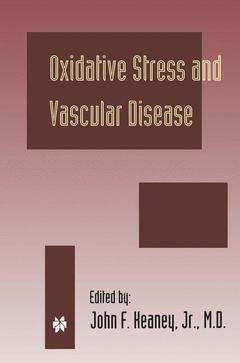Oxidative Stress and Vascular Disease, Softcover reprint of the original 1st ed. 2000 Developments in Cardiovascular Medicine Series, Vol. 224
Langue : Anglais
Auteur : Keaney Jr. John F.

One of the major biomedical triumphs of the post-World War II era was the defmitive demonstration that hypercholesterolemia is a key causative factor in atherosclerosis; that hypercholesterolemia can be effectively treated; and that treatment significantly reduces not only coronary disease mortality but also all cause mortality. Treatment to lower plasma levels of cholesterol - primarily low density lipoprotein (LDL) cholesterol - is now accepted as best medical practice and both physicians and patients are being educated to take aggressive measures to lower LDL. We can confidently look forward to important decreases in the toll of coronary artery disease over the coming decades. However, there is still uncertainty as to the exact mechanisms by which elevated plasma cholesterol and LDL levels initiate and favor the progression of lesions. There is general consensus that one of the earliest responses to hypercholesterolemia is the adhesion of monocytes to aortic endothelial cells followed by their penetration into the subendothelial space, where they differentiate into macrophages. These cells, and also medial smooth muscle cells that have migrated into the subendothelial space, then become loaded with mUltiple, large droplets of cholesterol esters . . . the hallmark of the earliest visible atherosclerotic lesion, the so-called fatty streak. This lesion is the precursor of the more advanced lesions, both in animal models and in humans. Thus the centrality of hypercholesterolemia cannot be overstated. Still, the atherogenic process is complex and evolves over a long period of time.
List of Contributors. Foreword. Preface. General Concepts. 1. What is Oxidative Stress; H. Sies. 2. Sources of Vascular Oxidative Stress; J.W. Heinecke. 3. Antioxidant Defenses in the Vascular Wall; R. Stocker. Atherosclerosis. 4. The Oxidative Modification Hypothesis of Atherogenesis; S. Tsimikas, J.L. Witztum. 5. Mechanisms of LDL Oxidation; M.R. McCall, B. Frei. 6. Oxidized Phospholipids as Mediators of Vascular Disease; S. Davies, et al. 7. MM-LDL and Atherogenesis - A Major Role for Phospholipid Oxidation Products; N. Leitinger, J.A. Berliner. 8. Oxidation-Sensitive Transcription and Gene Expression in Atherosclerosis; C. Kunsch, R.M. Medford. 9. Atherosclerosis, Oxidative Stress, and Endothelial Function; J.F. Keaney, Jr. 10. Oxidants and Antioxidants in Platelet Function; J.E. Freedman. 11. Antioxidants and Atherosclerosis: Animal Studies; J.F. keaney, Jr. 12. Human Studies of Antioxidants and Vascular Function; E.S. Biegelsen, J.A. Vita. 13. Antioxidants and Cardiovascular Disease; J.M. Gaziano. Diabetes. 14. Glycation and Glycoxidation in Diabetic Vascular Disease; S.R. Thorpe, et al. 15. Advanced Glycosylation Endproducts and Diabetic Vascular Disease; R. Bucala. 16. Hyperglycemia and Diabetes-Induced Vascular Dysfunction: Role of Oxidative Stress; G.M. Pieper. Hypertension and Vascular Remodeling. 17. The Role of Oxidative Stress in Hypertension; M.J. Somers, et al. 18. Protein Kinases That mediate Redox-Sensitive Signal Transduction; B.C. Berk. 19. Antioxidants and Restenosis: Animal Studies; J.F. Paolini, E.R. Edelman. Index.
Date de parution : 10-2012
Ouvrage de 373 p.
15.5x23.5 cm
Disponible chez l'éditeur (délai d'approvisionnement : 15 jours).
Prix indicatif 210,99 €
Ajouter au panierThème d’Oxidative Stress and Vascular Disease :
© 2024 LAVOISIER S.A.S.



